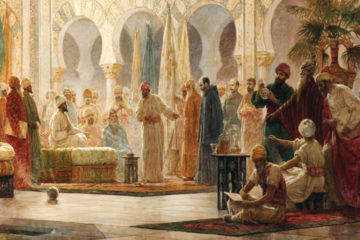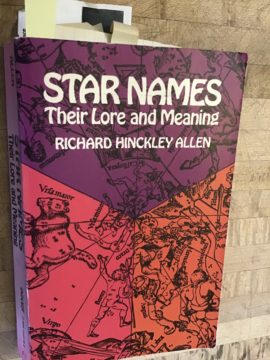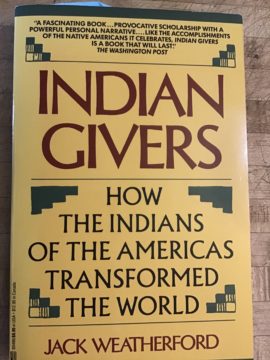by David Oates

In the short month since the first installment of this exploration, the news has returned to our theme. A few days ago (at this writing) a new squabble broke out over America’s supposed “Judeo-Christian heritage,” this time in Boston itself, seedbed of our original revolution. It seems the city government has rejected a request to fly a “Christian flag” outside the city hall. The reasoning offered for this request (if repetition of cliches based on historical fantasy can be called “reasoning”) was that it sought to “enhance understanding of our Judeo-Christian moral heritage.”
I would suggest that the cultural conservatives who try to rebrand America as a “Judeo-Christian” culture are not, in fact, conservative – since our founders were explicitly not interested in revealed religion as a basis for the new country. As Part I of this essay showed (if briefly!), the Founders looked to reason; they trusted the testimony of experience; they studied the ancient republics and democracies. There is no democracy in the Bible. That founding value came from elsewhere.
So these “cultural conservatives” are better described as reactionary fantasists. It’s the usual thing in backward politics – pining for an imaginary past.
In the real world, our Founders were above all children of the Enlightenment. As such, they wished to bring the clarity and factuality of science to all their deliberations. And preeminent among the sciences was astronomy, and the glittering record of success represented in Copernicus, Tycho Brahe, Kepler, Galileo, and Newton: those who dared to think first with their eyes, to lead with facts, and not to worry about offending those who wished only to repeat the guesses and legends of scriptured antiquity.
But the study of the heavens stretches back to ancient Greece, transmitted and developed by more recent Islamic civilization; and the math by which it was rationalized had roots in faraway nonwestern thinkers as well.
So the other half of the picture for our “Judeo-Pagan Tradition” is certainly the heritage of science, above all the astronomy and mathematics in which something approaching a true democracy of the mind offered around-the-world participation from tribes and nations and lonely outliers, from heathens and pagans near and far – without whom Western science could not have existed.
* * *
To pick an arbitrary starting point, algebra is an achievement of Islamic scholars, most famously the mathematician known as “al-Khwārizmī”:
in full Muḥammad ibn Mūsā al-Khwārizmī, (born c. 780 —died c. 850), Muslim mathematician and astronomer whose works introduced Hindu-Arabic numerals and the concepts of algebra into European mathematics. Latinized versions of his name and of his most famous book title live on in the terms algorithm and algebra.
In the 12th century a second work by al-Khwārizmī introduced Hindu-Arabic numerals . . .and their arithmetic to the West. . . . al-Khwārizmī also compiled a set of astronomical tables (Zīj), based on a variety of Hindu and Greek sources. This work included a table of sines, evidently for a circle of radius 150 units. Like his treatises on algebra and Hindu-Arabic numerals, this astronomical work (or an Andalusian revision thereof) was translated into Latin.

Other crucial mathematical breakthroughs like the invention of “zero” and the decimal point were contributed variously by Hindu and Islamic scholars. And the deep background laid by the classical Greek philosopher-mathematicians was conveyed to the west by Islamic scholarship.
So the “math” side of the Enlightenment has to be seen as a model of international/intercultural exchange. No purity there: only the restless and ever-fruitful sharing of knowledge.
And the astronomical side? Oh, that’s an even richer story that I can tell in a more personal voice.
In my tiny evangelical college, one of the ways for humanities majors to pick up some science credits was to take a night-time course in astronomy. Our campus sported an adorable little silver-domed observatory, about the size of a one-car garage, and the five or six students of our class would meet inside or out with our prof, a gaunt eccentric man with enormously bushy eyebrows whose enthusiasm . . . love . . . of the starry skies communicated itself to me like an intoxication.
Among many other useful facts, I picked up how to pronounce such impossibilities as (to pick just two) the stars “Betelgeuse” (beetle juice) or “Rasalhague” (ross-all-HOG –wee). How very strange the names of stars and constellations were! Soon I was carrying a star chart on my summerlong treks in the Sierra high country, and my solitary night-times became enlarged – impassioned – with the illimitable array overhead.
 Eventually I found myself also lugging along a lovely old late-Victorian guide to the heavens, the histories and names to be found there. (Like most Dover editions it was an inexpensive reprint of an older classic.) And there I found at last some explanation for the mysterious jaw-busting names of many heavenly bodies. I’ll reproduce enough to convey the charm of this account:
Eventually I found myself also lugging along a lovely old late-Victorian guide to the heavens, the histories and names to be found there. (Like most Dover editions it was an inexpensive reprint of an older classic.) And there I found at last some explanation for the mysterious jaw-busting names of many heavenly bodies. I’ll reproduce enough to convey the charm of this account:
Naturally these titles are chiefly from the Arabs, whose Desert life and clear skies made them very familiar with the stars.
But many star-names supposed to have originated in Arabia are merely that country’s translations of the Greek descriptive terms, adopted, during the rule of the Abbasids, from Claudius Ptolemy’s Great System of Astronomy, in our second century. . . .
The Greek of Ptolemy was translated into Arabic and thence, eventually, into a Latin version of the Arabic version.
This, published at Venice in 1515, so manifestly showed its composite origin that Ideler and Smyth have always referred to it as the Arabo-Latin Almagest. . . . From these and kindred works have come the barbarous Graeco-Latin-Arabic words that, in a varied orthography, appear as star-names in modern lists.
Happy was I to roam among such star-fields, somehow ancient and quaint and stupendous and cosmic, all at once. It made me feel barbarously human. Even in a solitary campsite high up on a Sierra mountain, with all the heavens spread out above me – I felt myself the heir of more than I could know.
The foundations of the European Enlightenment, its mathematics and its science of the heavens, are mongrel mixtures of pagan sources with later adoptions and advances by heathens and nonbelievers, leading along the way to Christian adopters and adapters.
And that wild admixture is what a culture is. What our culture is.
* * *
Against this jumbled backdrop of forebears – this salmagundi of influences – this world-bazaar of ideas and contributions. . . Whose god could be the god of this knowledge?
The Enlightenment was very clear about this question. A universal god could go by no merely local name, nor be the possession of any narrow scripture or dogma. Enlightenment thinkers who wished to reference a divinity took care to distinguish the august being from parochial versions contained in various sects and beliefs. They used instead language that would find its way into our Declaration of Independence: “The laws of nature and of nature’s God.” Nature’s God was explicitly not the god of anyone’s “revealed” religion, but rather the universal divinity known from the impartial witness of the natural world itself.
(See for example Matthew Stewart’s Nature’s God: The Heretical Origins of the American Republic: “America’s founders intended to liberate us not just from one king but from the tyranny of supernatural religion.”)
So it is pretty funny when the “Judeo-Christian Heritage” folks get excited about claiming their (nearly always) Christian God as virtually one of the Founders. One political charlatan who has worked this angle relentlessly, and often successfully, is the former Chief Justice of the Alabama Supreme Court, Judge Roy Moore. Moore also got a religious/political boost (at a campaign celebration of Moore’s Senate primary win) from recent Trump celebrity Steve Bannon, who speechified: “Judge Moore knows the Ten Commandments is the basis for the Judeo-Christian west!”

In the photograph you can see the gimmick which Moore rode to notoriety: a marble monument to the Ten Commandments, which he installed in the rotunda of the Alabama Judicial Building. When this was found to be a violation of the Constitution by a federal court, Moore refused to follow a court order to remove it, and was himself removed from office.
To round out the story: this kind of showboating apparently mesmerizes a certain sort of person. The citizenry of Alabama elected Moore a second time to the same state Supreme Court. This time he was removed from office because of his special antagonism to gay citizens and their rights, defying a U.S. Supreme Court decision (“Obergefell”) about same-sex marriage.
So it is worth an ironic laugh to see the way Moore’s monument (like Bannon’s comment) relies on ignorance about the Declaration of Independence and the thinking of those who wrote it. “Nature’s God” is explicitly not the god who gives special revelations to supposed prophets, but rather the god whose handiwork is seen around us in mountains and forests, sunsets and starry skies.
But neither Moore nor his followers could be expected to know that. Their fervent wish is to baptize the American Revolution and turn it into a Christian possession. But its roots are far broader and deeper than that: for it is, along with being Jewish, Christian, and Deist, also pagan, nonbelieving, nonconforming, nonsectarian. And, of course, heathen.
* * *
I can’t help but notice the special antipathy towards gay people in this account – and the way the word “nature” keeps popping up as these citizens (Republicans typically) attempt to turn back the clock on recently won social and legal LGBTQ freedom. Somehow they can’t resist the allure of labelling gay sexuality as “against nature.” We see it in Moore’s story, as in the news item in Part I of this essay about the Oklahoma GOP’s horror at including LGBTQ folks in their campaigning.
With Judge Moore’s monument in view, with its unintentionally ironic inscription, it’s possible to create some clarity by focusing on the persistent misuse of the word nature.
It should be clear the word “nature” is heavily loaded with implicit value. How many products are sold under the idea of being somehow more “natural”? Persuasive use of the words “nature” or “natural” is likely to be an attempt to claim that what is natural is good, and what is unnatural is bad. It works commercially, and it works in political argumentation.
Here’s the catch. How is “natural” to be determined? In the modern world, it is understood that nature is as you find it – nature can only be discovered empirically, through observation. What is the natural behavior of robins, or of sea urchins, or of viruses? No way to know except to observe, count noses, keep track, and then generalize from that. Nature is whatever is.
But in common conversation, the word “natural” is, instead, often used as a synonym for “good” or perhaps as a stand-in for “God.” “Natural” used in this sense is a value-judgment word, exactly the opposite of its accepted modern use as a neutral-observation word.
Because when scientists – say, anthropologists or historians – look at the humans, they use empirical means to discover what the “nature” of humans is. There is no a priori better or worse, no invisible standard, no “other world” of imagined ideal to which this world must live up. Instead the scientists observe whatever is. And what is the nature of the humans? Look around – there it is. For good or ill.
And to answer Judge Moore directly: by Enlightenment definition, “Nature’s God” did not produce the Ten Commandments – a religious prophet did.
* * *
James Loeffler of the University of Virginia, writing in The Atlantic, offers a telling sketch of the historical origins of the phrase “Judeo-Christian Tradition.” And it turns out to be a lot less historical than one might expect. Loeffler notes that the very idea would have been out of step with most American Christians in the eighteenth and nineteenth centuries, for they typically looked for the conversion of the Jews rather than seeing them as cultural partners or equals.
In fact the phrase originated much more recently. “The mythical ‘Judeo-Christian tradition’. . . . was one of 20th-century America’s greatest political inventions,” Loeffler says – firstly in the fight against fascism, as a way to declare common cause with Jews threatened by Nazis. And then, in the postwar period, as an “ecumenical market meme for combatting godless communism.”
He recalls the Cold War world where President Eisenhower was recruited to add markers of American piety onto our money (“In God We Trust”) and into our classrooms (the words “under God” added to the Pledge of Allegiance). Seen against this background, the phrase’s originally combative purpose simply continues in its use as a cudgel against other perceived cultural foes. (And in particular, in its continuing use against gay people: there’s a long, long history of queering ones enemies. In the nineteen fifties, fags were automatically suspect as possibly disloyal or “pinkos.” In the nineteen forties, even a bona fide war hero like Alan Turing was not safe.)
But even the pliable Ike felt the unseemliness of the excluding phrase “Judeo-Christian,” at least privately. He wrote to his brother in 1954:
You speak of the “Judaic-Christian heritage.” I would suggest that you use a term on the order of “religious heritage” – this is for the reason that we should find some way of including the vast numbers of people who hold to the Islamic and Buddhist religions when we compare the religious world against the Communist world. I think you could still point out the debt we all owe to the ancients of Judea and Greece for the introduction of new ideas.
When the President name-checks Judea and Greece, I feel him reaching toward “Judeo-Pagan.”
* * *
 The intro to this essay promises some good news from Indigenous Americans, and here it is. As the Framers struggled to define their new nation, there were examples available of successful political union that preceded the Europeans by centuries: The Iroquois Confederacy. And the colonists were far from blind to this example. Indeed, the political practices and achievements of the Indians offered the Founders guidance in (again) two broad ways. They are explored in Jack Weatherford’s well-known book Indian Givers: How the Indians of the Americas Transformed the World.
The intro to this essay promises some good news from Indigenous Americans, and here it is. As the Framers struggled to define their new nation, there were examples available of successful political union that preceded the Europeans by centuries: The Iroquois Confederacy. And the colonists were far from blind to this example. Indeed, the political practices and achievements of the Indians offered the Founders guidance in (again) two broad ways. They are explored in Jack Weatherford’s well-known book Indian Givers: How the Indians of the Americas Transformed the World.
One was in the way the lives of the Indians offered Europeans an example of almost shockingly libertarian personal freedom. Even today, Weatherford writes, Indian society as he observes it displays “respectful individualism and equality,” much as it did “when the first explorers wrote about it five centuries ago.”
The most consistent theme in the descriptions penned about the New World was amazement at the Indians’ personal liberty, in particular their freedom from rulers and from social classes. . . . For the first time the French and the British became aware of the possibility of living in social harmony and prosperity without the rule of a king.
The liberty of the Indians became a watchword in Europe of the fifteen hundreds. I’ve seen it in the writings of Montaigne, for example – a near-disbelief, a sense of discovery, that such a thing is possible in the real world. As reported by the explorer Lahontan, for example, Weatherford gives these words from a Huron:
We are born free and united brothers, each as much a great lord as the other, while you are all slaves of one sole man. I am the master of my body, I dispose of myself, . . . subject only to the great Spirit.
The Indians became a kind of fad in Europe, and it’s not hard to see why. Their lives seemed to offer hope of some less oppressive way of living. And this example played a huge role in the developing European ideas of freedom.
During this era the thinkers of Europe forged the ideas that became known as the European Enlightenment, and much of its light came from the torch of Indian liberty that still burned brightly in the brief interregnum between their first contact with the Europeans and their decimation by the Europeans.
The revolutionary pamphleteer Thomas Paine was particularly engrossed in the Indian example. In fact he had worked as secretary to commissioners sent to negotiate with the Iroquois in 1777. “[A]nd throughout the remainder of his political and writing career he used the Indians as models of how society might be organized. . . . By the time Paine died, the Indians had been permanently enshrined in European thought as exemplars of liberty.”
We often think of “freedom” as a key value of the Enlightenment. It is enlightening indeed to learn how much of this notion was a gift from the original peoples of the New World.
* * *
Not surprisingly, in their search for models of unity combined with freedom – some way to improve on the Articles of Confederation – Madison and the Framers looked to the political arrangements of the Indians. And this offers the second great contribution of the as-yet unChristianized New World to the structure of the Constitution: the famous Iroquois Confederation.
Reportedly, the first person to propose a union of all the colonies and to propose a federal model for it was the Iroquois chief Canassatego, speaking at an Indian-British assembly in Pennsylvania in July 1744.
The famous League of the Iroquois had been founded by the near-legendary Hiawatha and other chiefs “sometime between A.D. 1000 and 1450 under a constitution they called the Kaianerekowa or Great Law of Peace.” Weatherford represents the Iroquois nation as the greatest political entity north of the Azetcs, a carefully wrought confederation of five (later six) semi-autonomous yet strongly united Indian nations. And it had kept the peace, through carefully crafted institutions of representation and joint decision-making, for hundreds of years.
Among its promoters as a possible political model was Benjamin Franklin, whose first public office had been as Indian Commissioner of the Iroquois during the 1750s. He was impressed at what he saw, and “became a lifelong champion of the Indian political structure and advocated its use by Americans.”
In the end, the American system incorporated multiple features of the Iroquois system, notably the tendency to disperse authority (instead of gathering it to one dominating leader) and the techniques of joining the elements into a federal unity. For the Iroquois League offered what the short-lived Greek examples never did: a durable unity of multiple separate political entities, joined in a polity that respected the individual liberties not only of the member states, but also of the individual humans that constituted them.
It is sobering to realize how much the political substance and “uniqueness” of the United States owe to the original peoples of North America! A product this time not of “pagans” but of, properly speaking, “heathens” – peoples living geographically far from “Christian civilization.”
Of course, the exchanges and influences of the various cultures mentioned in these essays far exceed anything I’ve highlighted. It’s clear that we owe incalculably much to these civilizing and enriching influences from around the globe – we who inhabit this, our Judeo-Pagan Tradition.
